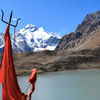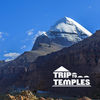Weather and Temperature of Kailash Mansarovar
Situated in the picturesque landscape of Tibet, the Kailash Mansarovar Yatra is considered one of the most sacred pilgrimages not only by Hindus but also by Jains and Buddhists. Thousands of Yatries from all across the world visit this holy place every year. The divine spiritual journey to Kailash Mansarovar can provide reincarnation and purification of the soul.
The Kailash Mansarovar Yatra season is from May to September. Each month has some positive and negative points. To witness the aura and beauty of this holy place, one needs to visit Kailash Mansarovar at the right time with the appropriate weather conditions. Kailash Mansarovar has a cold and dry type of climate, with a major temperature difference between day and night. The in depth detail about the Kailash Parvat Weather is given below:
Kailash Mansarovar in Summer Season
April, May and June is the summer season in Kailash Mansarovar. It is the beginning month of the Kailash Mansarovar Yatra. The temperature during this time ranges from 8°C to 16°C in the day and lows of around 5°C at the night. May or June is also when one can witness the famous Saga Dawa Festival in Tibet.
Kailash Mansarovar in Monsoon Season
July to Mid August is the monsoon season in Kailash Mansarovar. Being a deserted land, the rain showers in Tibet don’t last for long and the land gets dried quickly. Quite a lot of people prefer this month because it is the holy month of Shravana. The average temperature during this time is 10°C to 23°C.
Kailash Mansarovar in Post-Monsoon Season
Late August to September is the post-monsoon season in Kailash Mansarovar. These months are considered best for Mount Kailash Parikrama as there is comparatively less crowd. The average temperature throughout the month is about 20°C during the day and 10°C during the night.
Kailash Mansarovar in Winter Season
October to March is the winter season in Kailash Mansarovar. The temperature during these months drops to as low as - 20°C with freezing cold wind blowing in the region. The snowfall starts in October, continues nonstop in November, December, January and February and starts reducing in March. The heavy snowfall and dropping temperature make the Kailash Mansarovar region inaccessible as the roads are blocked.
You must be inquisitive to know the temperature of the Kailash Mansarovar locale before taking a sacred trip to Kailash Mansarovar. Based on our research, Trip To Temples provides you with a provisional weather and temperature chart for important destinations falling on the Kailash Mansarovar route.
Weather and Temperature in Kailash Mansarovar Yatra by Heli route:
Lucknow is the capital city of Uttar Pradesh. Being well connected with all modes of transport, The Kailash Mansarovar Yatra Package from Lucknow is the most popular one. Lucknow is the starting and ending point of this Kailash Mansarovar Yatra route by helicopter. People alternatively start their Kailash Mansarovar Yatra by Helicopter from Kathmandu also. Lucknow is located at a distance of 185km from the Nepal border. Lucknow lies in the Northern hemisphere, the climate is mild and generally warm and temperate. Summer starts in May and ends in September.
The helicopter and flight service for Kailash Mansarovar Yatra starts from Nepalganj. It is a small town in Nepal located about 185km from the Indian border. It is well connected to the border town of Uttar Pradesh, India. Lying in the Northern hemisphere, Nepalganj also has a climate similar to that of Lucknow. May is the warmest month and January is the coldest month.
-
Simikot, Humla district (2910m)
Simikot is a hidden gem of the Humla district of Nepal. The town offers a mesmerizing view of hills and lush greenery. It is the primary spot from where you may start feeling the impact of elevation. Simikot has a continental type of climate, summers are short and mild and winters last longer.
-
Hilsa, Humla district (3640m)
Hilsa is a small village on the Nepal- Tibet border from where you cross the hanging bridge on the Karnali river to enter Tibet for Kailash Mansarovar Yatra. This Karnali river is the only major river in the Kailash Mansarovar route. It resembles Ladakh of India in terms of terrain and climate. Hilsa has a cold climate for most part of the year.
-
Purang Town [Taklakot] (3900m)
Purang is a small and clean town with lots of shops on both sides of the road. You can purchase necessary items from the market and prepare yourself for Kailash Mansarovar Yatra. The town remains cold most of the time as it has a cold arid climate and summers are short and mild.
Mansarovar is the holiest lake in Tibet. It is believed that Lord Shiva and Indra Deva swam here as Swans. According to Hindu Mythology, Lake Mansarovar was first created by Lord Brahma in his mind and was later materialized on Earth. It is at Lake Mansarovar that you get the first glimpse of Mount Kailash. During the Kailash Yatra season, the weather at Lake Mansarovar remains mild and pleasant. The cold and fast wind blows during the night.
Darchen is the base for Mount Kailash Parikrama. It is a small town located in the south of Mount Kailash. The environment and people of Darchen are very hospitable. The town comes to light during the Saga Dawa Festival of Tibet. The weather in Darchen is cold and windy. It is advisable to wear warm clothes and cover your head and ear properly to avoid the cold wind hitting you.
Mount Kailash or the Kailash Parvat is the first of Panch Kailash. It is situated in Tibet- the autonomous region of China. The mountain is considered holy and is important for Hinduism, Jainism and Buddhism. According to ancient myths, Mount Kailash is the birthplace of the entire universe. The greatness of this holy peak cannot be explained in words. Mount Kailash is one of the coldest areas of the Kailash Mansarovar Yatra. Being a place of high altitude, the weather is harsh and the oxygen level is low at Mount Kailash. You will feel cold throughout Mount Kailash Parikrama.
After completing the first day 10km Parikrama of Mount Kailash from Yamdwar, the yatries reach Dhirapuk. It is the point which gives you the best view of Mount Kailash between two mountain ranges. One can get to see Silver and Golden Kailash from Dhirapuk.
On the second day, 22km Parikrama of Mount Kailash from Dhirapuk takes you to Zuthulpuk. This 22km trek is divided into 6km uphill, 6km downhill and 10km plain. En route to Zuthulpuk, one gets to witness Shivasthal, Dolma La Pass (the highest point of Kailash Mansarovar Yatra), and Gauri Kund.
Weather and Temperature in Kailash Mansarovar Yatra by Bus route:
Kathmandu is the starting point of the Overland Kailash Mansarovar Yatra Package. Located in the Himalayas, Kathmandu is the capital city of Nepal. While starting the Kailash Mansarovar Yatra from Kathmandu, you will also get to seek blessings at Pashupatinath Ji Mandir, Boudhnath Stupa, and Jal Narayan Vishnu Temple. Kathmandu lies in the temperate zone and has a mild climate throughout the year, generally warm and temperate.
Syabrubesi is one of the most beautiful villages in Nepal covered in green hills. The amazing location of Syabrubesi makes it the base for many popular trekking trails in Nepal and a gateway for Langtang Valley. Syabrubesi has a temperate climate and temperature ranges between 20°C to 30°C in summers and 10°C to 20°C in winters.
Kyirong is the gateway village between Nepal and Tibet. It is considered the most beautiful valley of Tibet with lush green surroundings and snow-capped mountains. Kyirong is also known as the Valley of Happiness. The weather in Kyirong is similar to that of Nepal because of its close proximity to the Nepal border. The temperature remains warmer and more humid than in other parts of Tibet.
Dongba has been an ancient trading hub of Tibet on the Tea Horse Road. It is a town famous for its Tibetan folk houses. There are many small shops and markets available to buy things for Kailash Yatra. The summers in Dongba are long and warm and the winters are short and freezing.
Saga is a beautiful and last major town on the Kailash Mansarovar Yatra route. It offers stunning views of the Tibetan plateau landscape and the Himalayan Mountains. The town is popularly known as Happy Land. Saga has a mainly dry climate with a typical semi-arid plateau climate with temperatures ranging as high as 23°C in summers to as low as -23°C in winters.
Mansarovar is the holiest lake in Tibet. It is believed that Lord Shiva and Indra Deva swam here as Swans. According to Hindu Mythology, Lake Mansarovar was first created by Lord Brahma in his mind and was later materialized on Earth. It is at Lake Mansarovar that you get the first glimpse of Mount Kailash. During the Kailash Yatra season, the weather at Lake Mansarovar remains mild and pleasant. The cold and fast wind blows during the night.
Darchen is the base for Mount Kailash Parikrama. It is a small town located in the south of Mount Kailash. The environment and people of Darchen are very hospitable. The town comes to light during the Saga Dawa Festival of Tibet. The weather in Darchen is cold and windy. It is advisable to wear warm clothes and cover your head and ear properly to avoid the cold wind hitting you.
Mount Kailash is the first of Panch Kailash. It is situated in Tibet- the autonomous region of China. The mountain is considered holy and is of great importance for Hinduism, Jainism and Buddhism. According to history, Lord Shiva resided here with his family. The greatness of this holy peak cannot be explained in words. Mount Kailash is one of the coldest areas of the Kailash Mansarovar Yatra. Being a place of high altitude, the weather is harsh and the oxygen level is low at Mount Kailash. You will feel cold throughout Mount Kailash Parikrama.
After completing the first day 10km Parikrama of Mount Kailash from Yamdwar, the yatries reach Dhirapuk. It is the point which gives you the best view of Mount Kailash between two mountain ranges. One can get to see Silver and Golden Kailash from Dhirapuk.
On the second day 22km Parikrama of Mount Kailash from Dhirapuk takes you to Zuthulpuk. This 22km trek is divided into 6km uphill, 6km downhill and 10km plain. En route to Zuthulpuk, one gets to witness Shivasthal, Dolma La Pass (the highest point of Kailash Mansarovar Yatra), and Gauri Kund.












